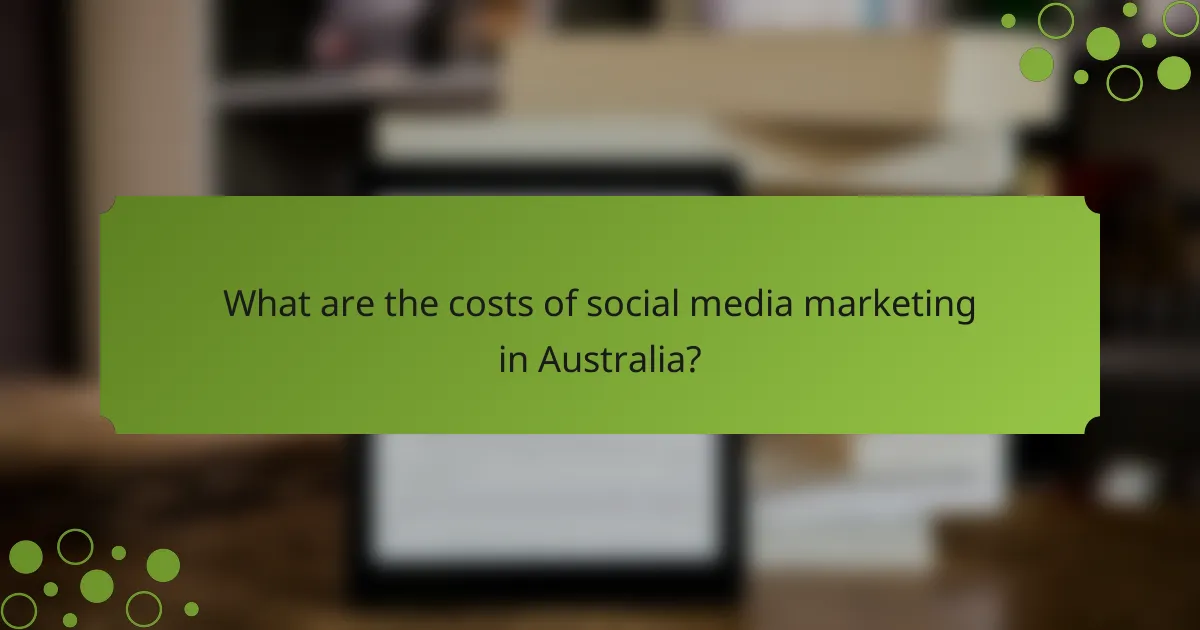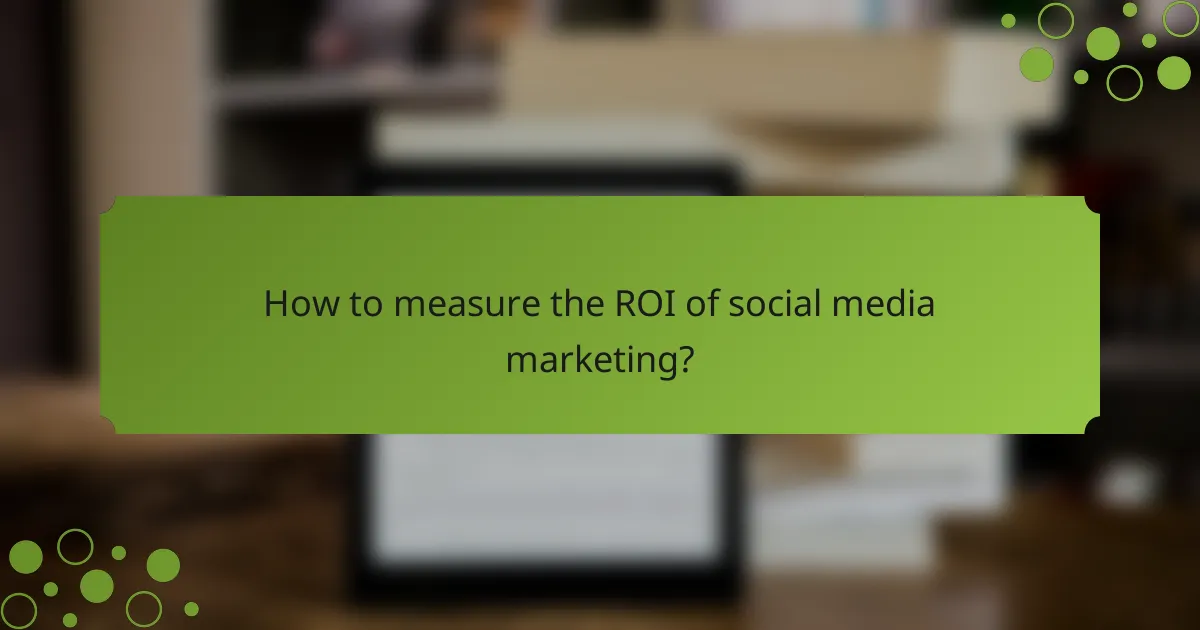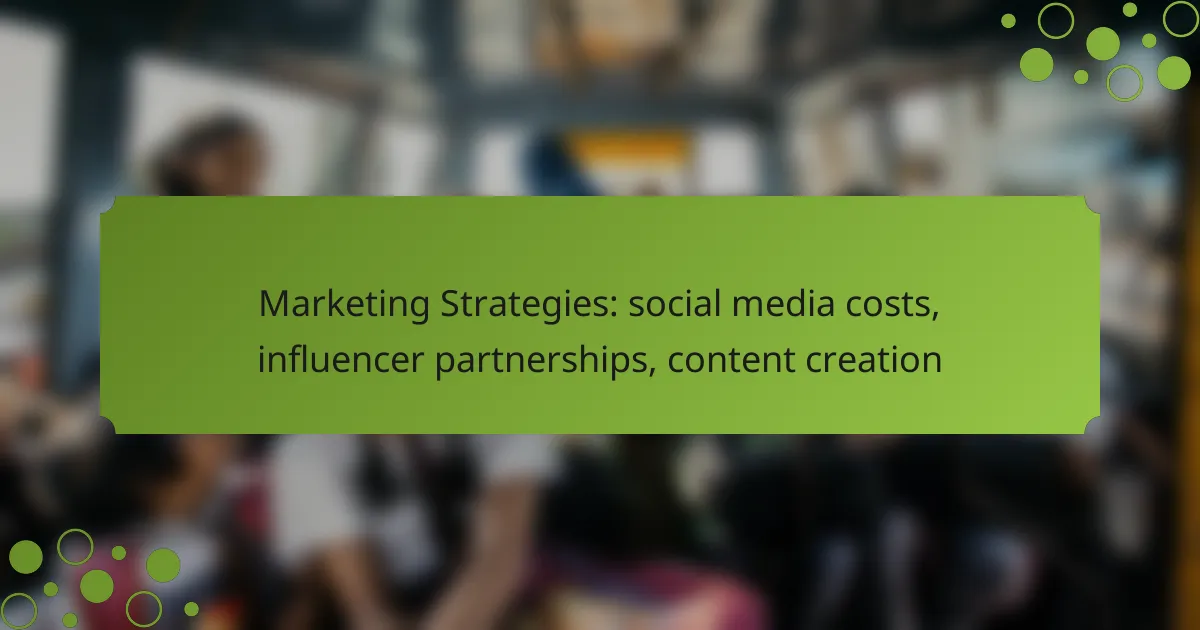In today’s digital landscape, effective marketing strategies are essential for businesses looking to thrive. Social media marketing costs can vary widely, influenced by platform selection and campaign goals, while influencer partnerships can enhance brand visibility when aligned with target audiences. Additionally, successful content creation focuses on delivering engaging and relevant material that resonates with consumers, ensuring a strong connection and maximizing impact.

What are the costs of social media marketing in Australia?
The costs of social media marketing in Australia can vary significantly based on factors like platform choice, audience targeting, and campaign objectives. Businesses typically allocate budgets ranging from a few hundred to several thousand Australian dollars each month, depending on their marketing goals.
Average monthly budget for social media ads
In Australia, the average monthly budget for social media advertising often falls between AUD 1,000 to AUD 5,000 for small to medium-sized businesses. Larger companies may invest upwards of AUD 10,000 monthly. It’s essential to assess your target audience and campaign objectives to determine an appropriate budget.
When setting your budget, consider factors such as the platforms you plan to use, the type of content you will create, and the expected return on investment. Regularly reviewing and adjusting your budget based on performance metrics can help optimize your spending.
Cost per click for Australian audiences
The cost per click (CPC) for social media ads targeting Australian audiences typically ranges from AUD 0.50 to AUD 2.00, depending on the platform and industry. For instance, competitive sectors like finance may see higher CPCs, while niche markets might experience lower costs.
To manage CPC effectively, focus on creating engaging content that resonates with your audience. Utilize A/B testing to refine your ads and identify the most cost-effective strategies for reaching your target market.
Influencer marketing expenses in Australia
Influencer marketing costs in Australia can vary widely based on the influencer’s reach and engagement levels. Micro-influencers may charge between AUD 100 to AUD 1,000 per post, while established influencers can demand AUD 5,000 or more for a single campaign.
When budgeting for influencer partnerships, consider not only the fees but also potential additional costs, such as product samples or campaign management. Collaborating with influencers who align with your brand values can enhance authenticity and improve campaign effectiveness.

How to choose the right influencer for your brand?
Choosing the right influencer for your brand involves aligning their audience, values, and content style with your marketing goals. Focus on influencers who resonate with your target demographic to maximize engagement and authenticity.
Criteria for selecting influencers
When selecting influencers, consider their audience size, engagement rates, and relevance to your brand. Look for influencers whose followers match your target market in terms of demographics and interests.
Evaluate the influencer’s content quality and consistency. Authenticity is key; choose influencers who create genuine content that reflects your brand’s values. Check their previous partnerships to ensure they align with your brand image.
Finally, assess the influencer’s communication style and professionalism. A good partnership requires clear communication and mutual respect, so prioritize influencers who demonstrate these qualities.
Top influencer marketing platforms in Australia
In Australia, several platforms can help you connect with influencers effectively. Popular options include Upfluence, AspireIQ, and Tribe, each offering unique features for influencer discovery and campaign management.
Upfluence provides a comprehensive database of influencers, allowing brands to filter by niche, audience demographics, and engagement metrics. AspireIQ focuses on building long-term relationships and offers tools for managing collaborations.
Tribe is known for its user-friendly interface and focuses on micro-influencers, making it ideal for brands looking to engage niche audiences. Consider your specific needs and budget when selecting a platform to ensure the best fit for your influencer marketing strategy.

What are effective content creation strategies?
Effective content creation strategies focus on producing engaging, relevant, and valuable material that resonates with your target audience. This involves understanding audience preferences, utilizing various content formats, and leveraging the right tools for distribution and management.
Types of content that engage Australian audiences
Australian audiences are particularly responsive to visually appealing content, such as videos, infographics, and high-quality images. Additionally, storytelling through blogs and articles that reflect local culture and interests can foster a deeper connection.
Interactive content, like quizzes and polls, also garners attention, as it encourages participation and shares insights. Brands should consider incorporating local events, trends, and humor to make their content more relatable and engaging.
Tools for content creation and management
Several tools can streamline content creation and management, enhancing efficiency and collaboration. Platforms like Canva and Adobe Spark are excellent for designing graphics and visuals, while tools such as WordPress and HubSpot facilitate content publishing and management.
For social media management, Hootsuite and Buffer allow users to schedule posts and analyze engagement metrics. Utilizing these tools can help marketers maintain a consistent content calendar and optimize their strategies based on performance data.

How to measure the ROI of social media marketing?
Measuring the ROI of social media marketing involves assessing the financial return generated from social media activities against the costs incurred. This evaluation helps businesses understand the effectiveness of their social media strategies and optimize their marketing budgets accordingly.
Key performance indicators for social media
Key performance indicators (KPIs) for social media include metrics such as engagement rates, conversion rates, and reach. Engagement rates reflect how well your audience interacts with your content, while conversion rates indicate how many users take desired actions, such as making a purchase or signing up for a newsletter.
Other important KPIs are follower growth and click-through rates. Follower growth shows the increase in your audience size, and click-through rates measure the effectiveness of your calls to action. Tracking these metrics helps identify successful strategies and areas for improvement.
Tools for tracking social media ROI
Several tools can assist in tracking social media ROI effectively. Platforms like Google Analytics provide insights into website traffic generated from social media channels, allowing you to measure conversions and revenue directly linked to social media efforts.
Social media management tools such as Hootsuite and Sprout Social offer built-in analytics features to monitor engagement and performance across different platforms. These tools can help streamline the process of gathering data and generating reports, making it easier to assess the overall impact of your social media marketing.

What are the prerequisites for a successful marketing strategy?
A successful marketing strategy requires a deep understanding of your target audience and clearly defined marketing goals. These elements guide your approach and ensure that your efforts resonate with potential customers.
Understanding your target audience
To effectively reach your audience, start by identifying their demographics, interests, and behaviors. Utilize tools like surveys, social media analytics, and market research to gather insights about what drives your audience’s decisions.
Consider creating buyer personas that encapsulate the characteristics of your ideal customers. This helps tailor your messaging and content to meet their specific needs and preferences, ultimately enhancing engagement and conversion rates.
Setting clear marketing goals
Establishing clear marketing goals is essential for measuring success and guiding your strategy. Use the SMART criteria—Specific, Measurable, Achievable, Relevant, and Time-bound—to formulate goals that provide direction and focus.
For example, instead of a vague goal like “increase brand awareness,” aim for “increase social media followers by 25% in six months.” This specificity allows for better tracking of progress and adjustments as needed to stay on target.

How to integrate social media with other marketing channels?
Integrating social media with other marketing channels involves creating a cohesive strategy that aligns messaging and branding across platforms. This approach enhances customer engagement and improves overall marketing effectiveness.
Cross-channel marketing strategies
Cross-channel marketing strategies focus on delivering a unified customer experience across various platforms, including social media, email, and websites. To implement this, brands should ensure consistent messaging and visuals, utilizing tools like marketing automation software to synchronize campaigns. For example, a promotional email can direct users to a social media contest, encouraging interaction on multiple fronts.
Consider using analytics to track performance across channels, adjusting strategies based on what resonates best with your audience. Regularly review engagement metrics to refine your approach and optimize resource allocation.
Benefits of an omnichannel approach
An omnichannel approach enhances customer experience by providing seamless interactions regardless of the platform. Customers appreciate being able to switch between social media, email, and in-store experiences without losing continuity. This can lead to increased loyalty and higher conversion rates.
Additionally, businesses can benefit from improved data collection and insights. By analyzing customer behavior across channels, companies can tailor their marketing efforts more effectively. For instance, if social media engagement spikes after a specific email campaign, it may indicate a successful cross-channel strategy that can be replicated.

What are the emerging trends in social media marketing?
Emerging trends in social media marketing include the integration of artificial intelligence, the evolving landscape of influencer partnerships, and the increasing dominance of video content. These trends are reshaping how brands engage with their audiences and allocate their marketing budgets.
Impact of AI on content creation
Artificial intelligence is revolutionizing content creation by automating processes and enhancing personalization. Tools powered by AI can analyze audience data to generate tailored content, optimizing engagement and relevance.
Marketers can leverage AI for tasks such as social media scheduling, content curation, and even generating written or visual content. This not only saves time but also allows for more data-driven decision-making.
Future of influencer partnerships in Australia
In Australia, influencer partnerships are becoming more strategic and data-driven. Brands are increasingly focusing on long-term collaborations rather than one-off promotions, fostering deeper connections with audiences.
As regulations around influencer marketing tighten, transparency and authenticity are crucial. Brands should ensure that partnerships comply with local advertising standards, such as disclosing paid promotions to maintain trust with consumers.
Growth of video content on social platforms
Video content is rapidly growing on social media platforms, with users increasingly preferring dynamic and engaging formats. Short-form videos, in particular, are gaining traction, driven by platforms like TikTok and Instagram Reels.
To capitalize on this trend, brands should focus on creating high-quality, visually appealing videos that convey their message quickly. Aiming for videos that are under a minute can significantly enhance viewer retention and engagement rates.
